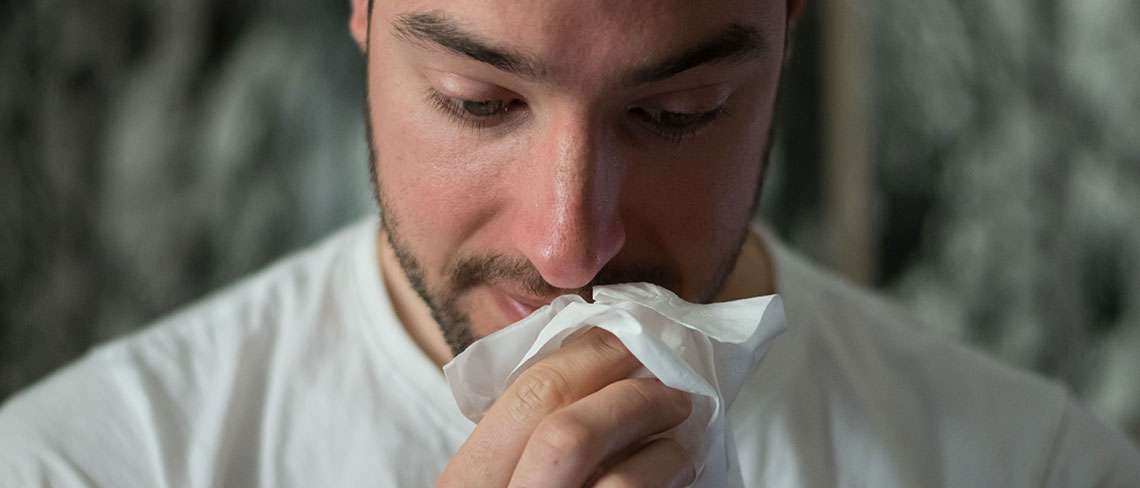
Brits are clueless when it comes to detecting humidity in the home.
Ecoair provides expert guidance on protecting against the adverse effects of humidity on our health.
- 79 percent of Brits have lived in a property affected by condensation, damp or mould
- Despite this, over one in five (21 percent) of Brits are unaware of the issue of excess moisture in the home
- 84.6 percent admit to never checking humidity levels in the home, with 71.7 percent clueless as to how to do so
- Only 6.2 percent of us correctly identify the point at which our home is too humid
- New research by Ecoair highlights the invisible dangers of cranking up the heating and keeping the windows closed during winter
With the cold weather now well and truly upon us, it’s inevitable that we’ll reach for the thermostat, crank up the heating and close windows and doors in an attempt to keep the environment toasty for the next few months.
Seems like the right thing to do, however, comfort-obsessed Brits could be turning a blind eye to the invisible dangers that come with living in a warm and under-ventilated living space.
New research, commissioned by Ecoair, shows that despite 79 percent of Brits having lived with damp, mould or condensation in their property, over one in five (21 percent) are unaware of the issue of excess moisture in their homes, which can have serious effects on health.
What’s more concerning is that 17 percent don’t believe humidity can have any negative impact on our health at all.
Whilst almost two thirds of Brits (65.6 percent) associate excess moisture in the home with visible signs such as mould, mildew or damp, less than a quarter (23.5 percent) believe humidity to be related to illnesses such as colds, flu and other bacterial or viral infections.
Worryingly, over half (53 percent) admit they would not take action to check humidity until they have witnessed visible signs or damage, whilst a whopping 84.6 percent admit to never checking humidity levels in the home, and 71.7 percent confess they are clueless as to how to do so.
It’s unsurprising in this case that 46 percent freely admit to not knowing the point at which our homes become too humid, with a further 47.7 percent of us getting it wrong.
A tiny 6.2 percent of the population is aware that humidity levels over 60 percent mean that we’re living with too much moisture. It is from this point that our homes become a breeding ground for microorganisms including bacteria, viruses and allergy triggering dust mites, putting us at risk of regular illnesses throughout the winter.
Homes exposed long term to excess moisture have a much higher chance of harbouring lung-damaging and sometimes highly toxic mould.
The research highlights the factors that people neglect to consider when the temperature starts to drop…
Unwittingly, Brits are subjecting themselves to an increased danger when blocking gaps, vents or using draught excluders, never opening windows in the winter, and turning up the heating. Even the increase in drinking hot drinks, cooking more, drying clothes inside and breathing contributes to the build-up of trapped moisture in our homes.
Bathrooms (52 percent) top the charts of rooms most affected by humidity issues. More troubling however, is the bedroom (30 percent), where we spend a huge chunk of our time on a daily basis.
Almost half of those surveyed (43 percent) will have children living or staying in their homes over winter. Children are particularly at risk from infections caused or exacerbated by living with high humidity and it’s important to protect them during the colder wetter winter months.
Ecoair co-founder and MD, Sally Fok, provides expert guidance and analysis of the research findings to ensure a healthier, humidity-free home this winter:
1. Why are our homes more humid in the winter?
“By turning on the heating and closing doors and windows during winter, we significantly reduce air circulation, causing moisture generated inside to become trapped indoors.
“Moisture from rain and melting snow can also enter our home through windows, floors or walls – particularly in older buildings.
“In the meantime, condensation of moisture on cold surfaces such as windows, ceilings, floorboards and walls, due to the difference between indoor and outdoor temperatures, is a major cause of trapped excess moisture in all homes throughout the winter.”
2. How are we exacerbating the problem?
“A huge majority of us are inadvertently making the problem worse and therefore putting our health at risk. It’s a common misconception that turning the heating up will reduce humidity, however, warm air carries more moisture!
“Humid air in a warm interior will find any colder surface, such as windows or walls, to condense, generating more condensation. Closing windows and curtains, air drying or hanging laundry on the radiator, taking long baths or showers, blocking vents, draughts or gaps, boiling the kettle, cooking, even breathing… can all contribute to the build-up of excess moisture in our homes.”
3. Why is humidity dangerous and what are the signs?
“Airborne microorganisms thrive in humid conditions. The survival and breed rate of bacteria, viruses or dust mites for example, will escalate as soon as humidity levels rise above 60%.
“This level of humidity is not at all uncommon in UK homes during the colder wetter winter months and the visible signs do not necessarily present themselves immediately.
“Visible signs of humidity include damp, mould, mildew, condensation, rotting or warped wood, peeling paint… If these are present, humidity in your home is way above optimum levels, so it’s vital to act quickly. As well as risking your health, you’ll likely also end up with costly damage repair bills.”
4. Why is humidity particularly dangerous for children?
“Children have weaker immune systems so there is an increased chance of them catching infections.
“Bacteria and viruses thrive and spread rapidly in a humid environment, so once an infection is brought home by any member of the family, excess moisture present in the air will increase the risk of everyone else in the house becoming infected.
“A humid environment will also aggravate existing conditions such as asthma or eczema and can trigger numerous allergies. So to keep children healthier and defend against winter bugs during the colder months, it is strongly advisable to check humidity levels and ensure they remain below 60%.”
5. How can we monitor the levels of humidity in our homes?
“Moisture levels can be measured by using a hygrometer. These are widely available online, inexpensive and will provide peace of mind.
“Any reading above 60% and it’d be strongly advisable to take steps to address the problem.
“It’s important to test all living spaces; it may be that the excess moisture only occurs in specific rooms.”
6. How can we protect ourselves against excess moisture build up?
“Ventilate. It is SO important. Good air circulation – even in winter – will allow excess moisture to escape and is key to warding off illness.
“Open windows regularly and use vent fans every time you are cooking and after taking a shower or bath. Allowing the air to circulate is a quick way to release trapped humidity.
“For those looking for a more immediate and controlled solution or in the case where humidity is continually showing levels higher than 60%, a dehumidifier can successfully restore and maintain the correct moisture levels in the home by extracting moisture from the air.
“Once humidity levels in the home are brought down to below 60%, airborne bacteria and viruses will not only stop breeding, but will struggle to survive.
“To control heavier cases of condensation on windows, damp or mould, it is advisable to bring the humidity down to 40% during the winter months.”
For more information on Ecoair, visit http://ecoair.org.
-Ends-
Notes to Editors:
- Research carried out by Opinion Matters with a nationally representative sample of 1,001 UK adults, between 13-16 November 2017
- Sally Fok, co-founder and MD of Ecoair, is available for comment or interview and can provide expert input or tips for features on air treatment.
For further press information:
Julie Aguilera/Allie Ford
Rooster PR
T: +44 (0)20 3440 8930
E: [email protected]
About Ecoair
Launched in 2006, Ecoair is one of the leading suppliers of air treatment products in the UK and the #1 supplier of desiccant dehumidifiers. It is the driving force behind the introduction of desiccant dehumidifier technology in the UK and one of the first to bring desiccant dehumidifiers to the semi industrial market.
Ecoair boasts the largest range of desiccant dehumidifiers for the domestic market in the UK and is the only company currently to offer a 10L capacity desiccant dehumidifier for UK domestic use.
Providing the most honest and accurate product specifications, Ecoair is committed to bring products to market that give much better results than those of competitors.
Specialising primarily in dehumidifiers (desiccant and compressor), Ecoair also offers fans, air purifiers and air conditioning units (portable, wall mounted, multi split, window or ceiling cassette units).
With a dedicated R&D team, Ecoair has in the last 3 years invested heavily in improving the desiccant technology and specifications. Ecoair believes that all companies have a social responsibility to achieve sustainability. Many AC and dehumidifier products on the market still contain HFC gas, which is harmful to the environment. Ecoair’s R&D is focused on working with sustainable sources to eliminate the need for HFC gas in its products.
For more information, visit http://ecoair.org, or follow Ecoair (@EcoairGB) on Facebook, Twitter and Instagram. To purchase an Ecoair dehumidifier, go to http://ecoairdirect.com.






